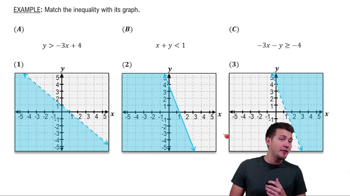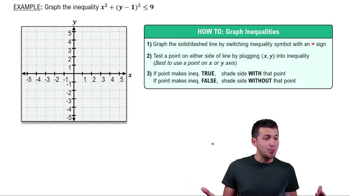Table of contents
- 0. Review of Algebra4h 16m
- 1. Equations & Inequalities3h 18m
- 2. Graphs of Equations43m
- 3. Functions2h 17m
- 4. Polynomial Functions1h 44m
- 5. Rational Functions1h 23m
- 6. Exponential & Logarithmic Functions2h 28m
- 7. Systems of Equations & Matrices4h 6m
- 8. Conic Sections2h 23m
- 9. Sequences, Series, & Induction1h 19m
- 10. Combinatorics & Probability1h 45m
7. Systems of Equations & Matrices
Graphing Systems of Inequalities
Problem 45c
Textbook Question
In Exercises 27–62, graph the solution set of each system of inequalities or indicate that the system has no solution. y≥x^2−1, x−y≥−1
 Verified step by step guidance
Verified step by step guidance1
Graph the inequality $y \geq \frac{x^2}{2} + 1$. This is a parabola opening upwards with vertex at $(0, 1)$. Shade the region above the parabola.
Graph the inequality $4x - 2y \geq -2$. First, rewrite it in slope-intercept form: $y \leq 2x + 1$. This is a line with slope 2 and y-intercept 1. Shade the region below the line.
Identify the intersection of the shaded regions from both inequalities. This is the solution set of the system.
Check if the boundary lines are included in the solution set. Since both inequalities are 'greater than or equal to' or 'less than or equal to', the boundary lines are included.
Verify the solution by selecting a test point from the intersection region and checking if it satisfies both inequalities.
Recommended similar problem, with video answer:
 Verified Solution
Verified SolutionThis video solution was recommended by our tutors as helpful for the problem above
Video duration:
1mPlay a video:
Was this helpful?
Key Concepts
Here are the essential concepts you must grasp in order to answer the question correctly.
Inequalities
Inequalities are mathematical expressions that show the relationship between two values when they are not equal. In this context, they indicate regions on a graph where certain conditions hold true, such as 'y is greater than or equal to a function of x'. Understanding how to interpret and graph inequalities is crucial for visualizing solution sets.
Recommended video:

Linear Inequalities
Graphing Quadratic Functions
Quadratic functions are polynomial functions of degree two, typically represented in the form y = ax² + bx + c. The graph of a quadratic function is a parabola, which can open upwards or downwards depending on the coefficient of x². In this problem, the inequality y ≥ (1/2)x² + 1 describes the region above the parabola, which is essential for determining the solution set.
Recommended video:

Graphs of Logarithmic Functions
Systems of Inequalities
A system of inequalities consists of two or more inequalities that are considered simultaneously. The solution set is the region where the graphs of the inequalities overlap. To solve such systems, one must graph each inequality and identify the common area that satisfies all conditions, which is critical for answering the given question.
Recommended video:
Guided course

Systems of Inequalities

 7:2m
7:2mWatch next
Master Linear Inequalities with a bite sized video explanation from Patrick Ford
Start learning




